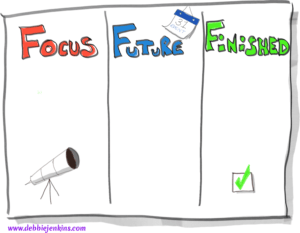Link to: Writing Waste 1. Not enough focus
Writing Waste 2: Too many ideas (Writing In Progress)
“Venus, I want to see Venus. Now Saturn! Saturn’s my favourite. Look Mars is coming up. Quick back to Venus, faster it’s going behind the mountain!”
When we moved to the #DisasterFarm a couple of years ago we were impressed with the lack of light pollution and the fantastic view of the stars. So I bought my Italian-Half a telescope (taller than me) for his birthday. I then tortured him nightly by insisting we swept the sky, moving from planet to planet, focusing in only to quickly move on again. I’m not allowed to play with his birthday present anymore.
This desire to move on to the next interesting thing, the next article, or shiny idea that pops into your head (the next exciting planet) is waste #2 – too many ideas. When you move on without fully appreciating or finishing what you started (counting the rings of Saturn!) you create waste. This waste is very closely aligned with Writing Waste #1, and follows on from fixing it.
If you followed my advice for Writing Waste #1, you now have a niche that you want to focus on, so you can avoid making more un-focused waste. You’ve probably got all excited, and you’re coming up with ideas for your new niche. You probably have a bazillion ideas, and a trazillion writing projects started. You’re now into the making focused waste stage, well done.
I call this “Shiny new document syndrome”: You are so prolific with ideas that you create a new book document every day. You have outlines for loads of interesting books. You jump from one to the next, writing a little, adding a new idea. Each book (or article) idea has 10 different titles and subtitle ideas (see waste #6). You have scraps of paper, open notebooks, post its, voice notes – hundreds of them. You probably end up writing a lot. But it all sits on your computer or your desk, because you never finish an idea, an article nor book. You just create a stack of Writing In Progress (WIP). You write in isolation and never get feedback, because you never ship. No one gets to read what you’ve written.
The causes of too many ideas come from not being able to discern what’s important right now. In the book Essentialism [1], Greg McKeown says we should ask ourselves: “Is this the very most important thing I should be doing with my time and resources right now?” We’ll look at how you make the decision in a minute, for now note the two parts to the question: time and resources. You really only have so many hours in the day, and finite resources to spend. How you spend your hours and resources is important – you need to stop wasting them. You must become more discerning. Building good judgment into your writing is a skill, and I have some tools and techniques to help you.
How to fix having too many ideas in progress
You can take the girl out of engineering, but you can’t take engineering out of the girl – I’m going to introduce you to an engineering tool – the Kanban [2]. You will have come across this in many different guises, it’s a visual way of showing work in progress and where it is in your system. The simplest Kanban would be a board on the wall, and have just three columns: To Do, Doing, Done. There would be multiple cards of work in progress in each column. As the work progresses through the system (the factory in the real Kanban), it moves from column to column, so you can see at any time where there are holdups – waste – in the system.
I’ve modified it a bit (of course!) and have the 3F Model (not to be confused with my 3F-Friday, which I’ll tell you about in Waste 3), with some simplified rules. Have a look at the model below, you can see there are 3 columns beginning with Fs (you can see how inventive I am with naming things!).
FOCUS: In this column you can only have ONE THING [3]. Just one, uno, ein, un, unu, ceann, หนึ่ง. You get my point – ONE.
FUTURE: This is where everything else goes. All 99 other writing projects sit here – all of them, no exceptions.
FINISHED: When you have finished a writing project (fully finished – shipped – other people are reading it finished*) you move your post-it here. Don’t underestimate the FINISHED column, this will grow, soon it will be bigger than your FUTURE column, you’ll feel fabulous and it will keep you going when writing gets tough.
Very simple. So, how do you decide on your ONE THING for the FOCUS column?
Capture your Writing In Progress (WIP)
Choose your weapon: either get a big white board and go old school style with post-its, or use a Kanban-esque internet-based, trendy system like Trello.com (I love Trello), where you can make columns and add notes, share with other people, move things easily without them falling off or flying away when you open the window. Make your 3F Model by creating 3 columns and writing: FOCUS, FUTURE and FINISHED at the top.
Capture your thoughts: take stock of all your WIP – writing projects currently in progress. Be honest! Make a list of each article, document, book idea that you have started and not finished. Write them down on post-it notes – one item per post-it. Stick them all on your real or virtual board – in the FUTURE column for now.
Evaluate the best idea (for now): select the one thing (for now). The article, book chapter, outline, speech, whatever writing project you’re working on – and put it in FOCUS.
Decide on the one thing – FOCUS FINDER
 You might be stuck on how you evaluate the best idea (for now). Let’s keep it simple – use the Focus Finder.
You might be stuck on how you evaluate the best idea (for now). Let’s keep it simple – use the Focus Finder.
Make a table with the following headings: Will serve my target audience; Will advance my business (or personal) goals; I have the time and resources; Total. If you don’t know who your target audience is, go back to Writing Waste #1.
List all your writing in progress in the first column. Score each idea on a scale of 1-3 with 1 being bad or hard, and 3 being easy or good. Then add up the scores. The WIP with the highest score wins – if you have a tie, then just pick ONE! Really, just pick your favourite, stop complexifying it (see waste # 5).
Now, do the ONE THING. Just do it till it’s done. Don’t stop till it’s shipped*.
When you’ve finished, re-evaluate (things change, you might have more time or resources…) and then do the next ONE THING.
You might be tempted to put “Write my booky wook” in the FOCUS column. DON’T DO THAT! That’s not ONE THING. (Sorry for the shouting, but I wanted to make sure you heard me.) A BOOK, a whole book, is not ONE THING! Really! A book needs to get broken down into smaller component parts, those parts – one at a time – can go in your FOCUS column. The rest go in the FUTURE. We’ll look at how you break a book down later in my articles, I promise.
Solution for too much Writing In Progress: Focus on one book chapter (or article, or speech, or course module) for now. You can write more later. Stop starting, start stopping.
* If you are the most discerning person in the world, and have justified judgment, then perhaps you are perfecting procrastination (see waste #6). Bad judgment might not be the reason you’re not shipping your writing. You might be struck with fear. Fear of being read, fear of being wrong, fear of sticking your head above the parapet, fear that people might not like what you’ve written. Read Waste #4 for some tips to get you moving, and Waste #6 to break through your procrastination.
Resources
[1] Essentialism: The Disciplined Pursuit of Less by Greg McKeown – not another “How to get more done in less time and be superman” book – a book about getting the right thing done. It’s about discipline.
[2] Kanban – Kanban is a scheduling system for lean manufacturing and just-in-time manufacturing.
[3] The ONE Thing: The Surprisingly Simple Truth Behind Extraordinary Results by Gary Keller – not just a beautiful cover, this is a beautiful book. From their blurb: “By focusing their energy on one thing at a time people are living more rewarding lives by building their careers, strengthening their finances, losing weight and getting in shape, deepening their faith, and nurturing stronger marriages and personal relationships.” OMFG – who doesn’t want all that?



